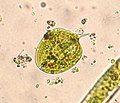Paramylon is a carbohydrate similar to starch. The chloroplasts found in Euglena contain chlorophyll which aids in the synthesis of carbohydrates to be...
3 KB (216 words) - 15:59, 29 March 2024
accepted. Euglena chloroplasts contain pyrenoids, used in the synthesis of paramylon, a form of starch energy storage enabling Euglena to survive periods of...
28 KB (3,064 words) - 00:09, 4 August 2024
through photosynthesis. This group is known to contain the carbohydrate paramylon. Euglenids split from other Euglenozoa more than a billion years ago....
18 KB (2,110 words) - 19:16, 25 July 2024
These changes include: increasing thickness of the cell, increase in paramylon bodies (both in size and number in Phacus curvicauda), and the overall...
25 KB (3,351 words) - 05:28, 10 December 2023
stacked in groups of three. Photosynthetic product is stored in the form of paramylon, which is contained in membrane-bound granules in the cytoplasm of the...
194 KB (18,825 words) - 19:04, 12 August 2024
green alga. They are distinguished from other algae by the presence of paramylon as a storage product and three membranes surrounding each chloroplast...
5 KB (676 words) - 02:21, 20 May 2024
Paramylon is a unique storage polysaccharide found in Euglena gracilis, serving as a reserve carbohydrate for energy storage. Structurally, paramylon...
10 KB (1,006 words) - 23:13, 20 May 2024
synthesized Propionic acid. He is also known for describing and naming Paramylon. Gottlieb was born in Brno as son to a pharmacist. He completed his Matura...
9 KB (822 words) - 17:41, 2 April 2024
synthase Identifiers EC no. 2.4.1.34 CAS no. 9037-30-3 Alt. names GS-II , paramylon synthetase , callose synthase Databases IntEnz IntEnz view BRENDA BRENDA...
4 KB (361 words) - 23:19, 16 August 2024
tapers to a "snout-like" extension. The cell is filled with very small paramylon grains. One specimen was described as containing phagocytosed algae. H...
3 KB (241 words) - 21:11, 13 May 2024
length and width measurements of the cells and flagella, the presence of paramylon grains in the cytoplasm, 16 pellicle strips, four rows of microtubules...
16 KB (2,305 words) - 02:26, 20 May 2024
from other Euglena species by its one axial, stellate chloroplast with a paramylon center in it. But there are still five species sharing these morphological...
7 KB (735 words) - 17:27, 12 April 2024
(8 May 2017). "Ultrastructural and immunocytochemical investigation of paramylon combined with new 18S rDNA-based secondary structure analysis clarifies...
5 KB (621 words) - 16:49, 28 April 2024
His doctoral work focused on biosynthesis of the storage carbohydrate paramylon in the alga Euglena. From 1987 to 1990 Kiss conducted post-doctoral work...
17 KB (1,358 words) - 09:57, 16 August 2024
they are colourless. Similar to other euglenoids, the cell has many paramylon bodies that are used for the storage of starch; these can be a distinguishing...
8 KB (951 words) - 04:53, 25 December 2023
cell membrane. The chloroplast lacks a pyrenoid, but cells still produce paramylon grains; two of them are present between the cell’s pellicle and the chloroplast...
11 KB (1,576 words) - 13:18, 30 June 2023
ventrally on the body of the cell. The cells also have an abundance of paramylon bodies, typically used for the storage of starch, that are observed in...
11 KB (1,026 words) - 15:25, 13 July 2024











